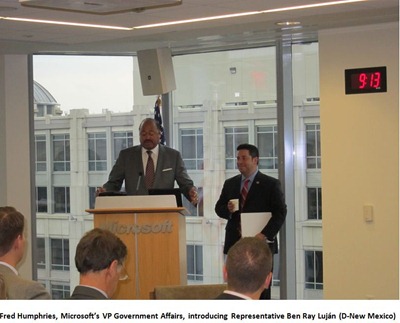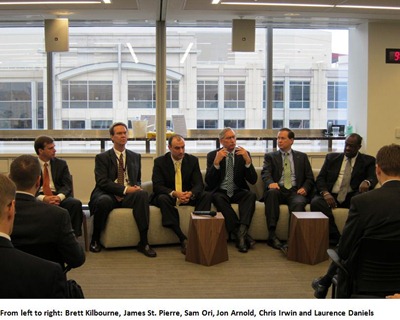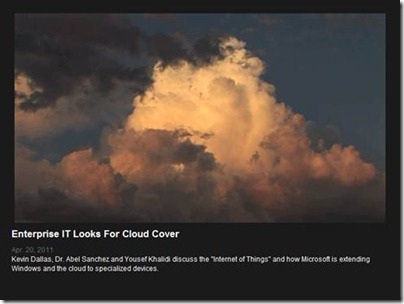The Role of The Cloud in The Smart Grid
Earlier this week I had the pleasure of participating in a panel discussion concerning visions for the Cloud in the advancement and development of the smart grid from a governmental and industry policy perspective. The setting was perfect, in Microsoft’s new Washington DC Office, and the event brought together a very knowledgeable and experienced group of people in positions to assess both the current progress of smart grid initiatives and its future needs. The timing couldn’t have been more prescient: the Cloud is one of the hottest topics in Information technology circles today and Utility industry CIOs are deeply engaged in developing their Cloud strategies for both the short- and long- term. Had the CIO’s been there, they would have heard the panelists’ robust discussions on Cloud issues in the context of policy, security, energy information rights, the responsibilities of consumers, utilities and the IT industry at large.
When you’re in Washington there’s no shortage of perspectives from informed leaders. We were honored to have U.S. Representative Ben Ray Luján (D-New Mexico)  provide the introductory remarks. Rep. Lujan set the stage by virtue of his position on the House Committee on Science, Space, and Technology’s Subcommittees on Technology and Innovation and Energy and Environment as well as the Natural Resources’ Subcommittee on Water and Power. Rep. Lujan confirmed that he and others understand how the Cloud could help the transformation to the electric power system of the future, not only by modernizing its existing operations but also by supporting new paradigms like consumer energy management and the introduction of electric vehicles (EVs).
provide the introductory remarks. Rep. Lujan set the stage by virtue of his position on the House Committee on Science, Space, and Technology’s Subcommittees on Technology and Innovation and Energy and Environment as well as the Natural Resources’ Subcommittee on Water and Power. Rep. Lujan confirmed that he and others understand how the Cloud could help the transformation to the electric power system of the future, not only by modernizing its existing operations but also by supporting new paradigms like consumer energy management and the introduction of electric vehicles (EVs).
After Rep. Lujan spoke , our moderator Rob Atkinson took over. Atkinson is President and Founder of the Information Technology and Innovation Foundation (ITIF) and is no stranger to the complexity of the technology policy issues he teed up for discussion by the group. (The event seems to have inspired Rob to blog as well. He blogged here about the panel and the Obama Administration’s recent report entitled “A Policy Framework for the 21st Century Grid: Enabling Our Secure Energy Future. Take a look.
In addition to myself and Rob, the other panelists represented a diverse cross-section of experts uniquely knowledgeable about the current state of the smart grid and its future. They included:
· Laurence Daniels - Assistant People’s Council, Office of the People’s Counsel, Washington D.C.
· Chris Irwin - Smart Grid Standards & Interoperability Coordinator, U.S. Department of Energy
· Brett Kilbourne - Deputy Counsel, Utilities Telecom Council
· Sam Ori - Director of Policy, The Electrification Coalition
· James St. Pierre - Deputy Director, Information Technology Laboratory, National Institute of Standards and Technology (NIST)
 The panel seemed to zero in on the issue of how the Cloud is different, and how it will change our ability to manage energy through its ability to handle the massive amount of data that is being generated now, and will be generated in the future.
The panel seemed to zero in on the issue of how the Cloud is different, and how it will change our ability to manage energy through its ability to handle the massive amount of data that is being generated now, and will be generated in the future.
From Microsoft’s perspective the Cloud differs from on-premise data management capabilities because of the ease of secure connectivity for the scale-out of billions of devices. As an example, think of the challenges to managing data coming from millions of electric vehicles, and the provision of services to customers, especially the locations of charging stations and the grid capacities for those stations. The resulting information Tsunami would be overwhelming, daunting and possibly prohibitively expensive for individual Utilities, especially if they were required to build the infrastructure on their own. As one part of the solution to those issues, we at Microsoft are working today with Utilities to assess how they can use the Cloud as a way to increase their agility, control their costs, and provide elasticity across their internal and external systems .
Another topic we discussed was the evolution of standards and technology and the issue of legacy systems. As smart grid technology evolves, people will ask how last year’s smart metering system remains a viable asset. How can the various stakeholders (IT companies, utilities, renewable energy generators, etc.) ensure that devices and applications can communicate?
We at Microsoft believe the answer resides in standards and reference architectures that provide prescriptive guidance on how to connect systems and ease interoperability pains. Our Smart Energy Reference Architecture is one example of how we have worked to help the industry in this regard. And, through my participation on the NIST Advisory Board, we support NIST efforts to coordinate the development of a framework that includes protocols and model standards for information management, to achieve interoperability of smart grid devices and systems.
Our panel also took up the issues specific to the Cloud, especially the need for standards for Cloud risk assessment. Many Cloud services already in the marketplace today are shrouded in secrecy in terms of how the services are run, where that data resides, how backups are stored, how security is managed, and failover procedures. The panel seemed well aware that if Utilities are going to be made comfortable tapping into Cloud services for significant smart grid projects, then international certifications, such as ISO/IEC 27001 and SAS 70 are critical for proper risk assessments. At Microsoft, we are proud to have achieved ISO 27001 certification and SAS 70 compliance for our Cloud data centers.
The panel ended our meeting on the topic of privacy. Certainly the advent of consumer energy management systems, smart meters and EV’s are heralding great concerns about consumer privacy and the delicate balance between privacy and functionality.
Our view is that privacy is not a tradeoff. You could balance comfort versus functionality where the more I am willing to give up on comfort, the more I get to participate in load management and demand response programs. But asking to marginalize privacy to obtain functionality is a tradeoff that we don’t think is necessary. Instead, we believe that technology can provide ways to obtain the needed functionality while at the same time providing privacy protections and meaningful choices for consumers. For consumers, we are strong advocates for the opt-in model where, for example, a consumer can opt-in (or out) for a third party to provide services for energy management. In our view, the consumers’ energy response profile should work for them as an agent without divulging usage data.
The core takeaway from our discussion was that more people from broad walks of government, industry, and policy setting organizations are beginning to expand their view on the Cloud’s applicability to the smart grid. As a result, the Cloud itself is evolving and we are seeing its impacts on many levels.
While Utilities are among the slowest adopters of new technologies due to their concerns about reliability (or, said another way, fixing things that aren’t broken), we are seeing increasing evidence of the Cloud’s effectiveness for consumer facing portals, meter data management, demand side management, occupational health and safety, power trading simulations, asset management and emergency response scenarios. It’s been an incredible journey, in a very short period of time, especially when compared to past implementations of new technologies.
I think that this is occurring in part because the smart grid evolution is forcing the convergence of OT and IT and is creating need for new approaches to solving complex problems, many of which we don’t even know about yet. The smart grid is adding billions of devices to the grid, your home and even in your car that will need to connect and communicate with scale, security and elasticity. How will we be able to create and manage this energy network?
will we be able to create and manage this energy network?
Two words: the Cloud.
In a recent blog I talked about the consumerization of IT but I asked the question: “What’ Next”. We believe the answer is using the Cloud as a way to connect the virtual world with the physical world. I leave you with a recent video that we produced highlighting the role of the Cloud as a way to connect the virtual world with the physical world. It’s “What’s Next”. – Jon C. Arnold